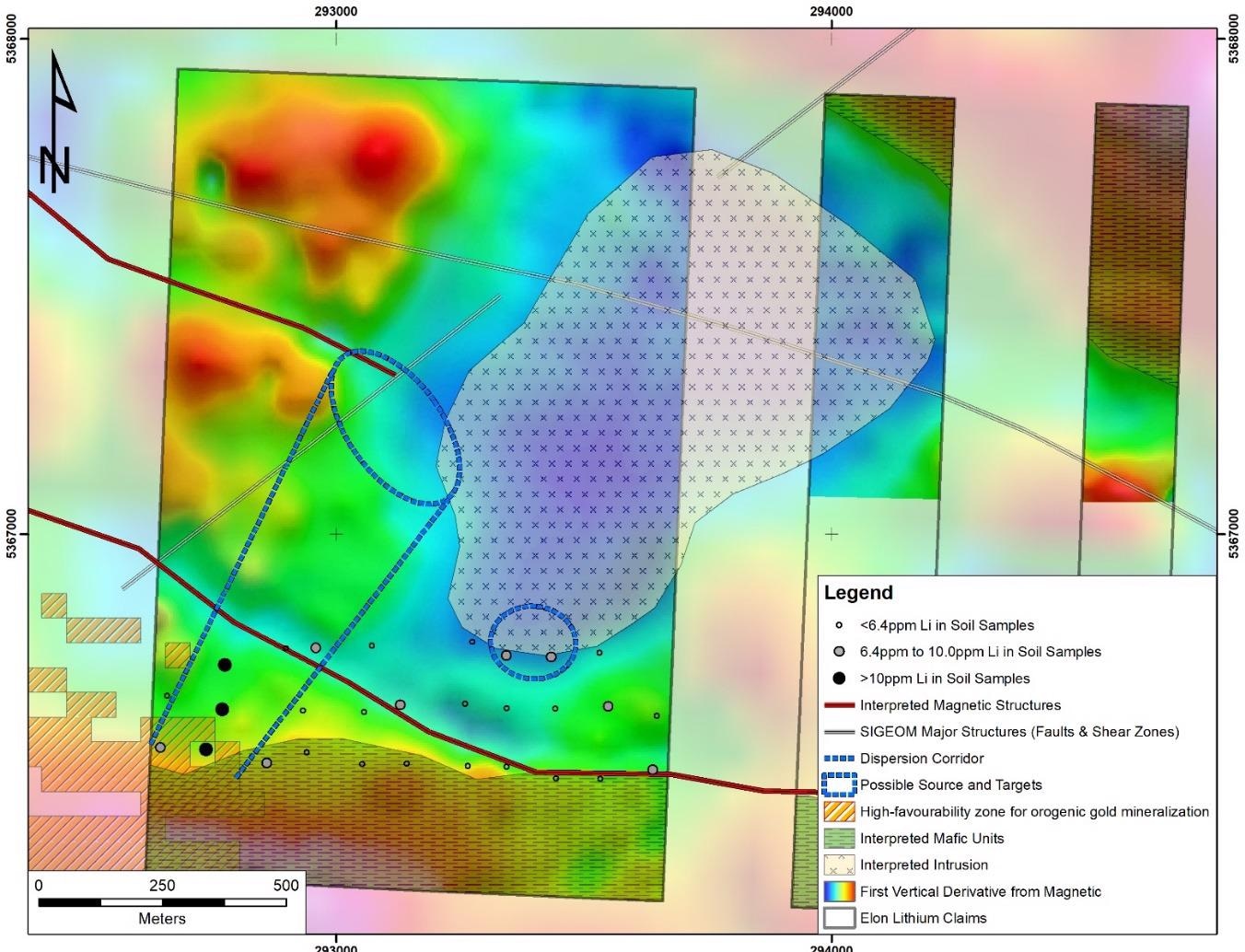Musk Metals takes pleasure in declaring that it has finished ground and airborne surveys as well as sampling and has determined two high-priority lithium or tantalum targets in the southwest portion of its wholly-owned Elon Lithium Property.
 Lithium Anomalies in Till and Structural Features, Over Mag. Image Credit: Musk Metals Corp.
Lithium Anomalies in Till and Structural Features, Over Mag. Image Credit: Musk Metals Corp.
It is situated nearly 600 m northeast of the Lithium Amérique du Nord project, in Abitibi, Quebec, which generated more than 907,000 tons of material, at 1.40% LiO2 from 1955 to 1965.
After a high-resolution heliborne magnetic survey conducted by Prospectair Geosurveys in Phase 1 of a three Phase exploration program, the Company ordered SL Exploration to carry out a soil sampling survey in July 2021, down-ice from magnetic anomalies found during the airborne survey.
The findings obtained reveal two lithium targets, that warrant additional exploration, situated at the contact of an interpreted intrusion contact. Also, the contact complies with structural characteristics that crosscut it, which could be pipelines for intrusions closely related to lithium mineralization.
We have systematically completed multiple surveys and sampling on the southwestern portion of the Elon property and are excited to test our two new high priority lithium targets.
Nader Vatanchi, CEO and Director, Musk Metals Corp.
Vatanchi added, “The airborne survey initially identified the magnetic anomalies, and the sampling and groundwork have confirmed their potential to host mineralization. The next phase of work at Elon is designed to provide MUSK with more samples and sufficient data for an anticipated drill program.”
Field Work
The new exploration program, conducted on the Elon Property, focused on the western claims of the Property. The survey aimed to complete a soil survey in till to better describe the prospect of the contact zone of a magnetic anomaly that may be connected to lithium mineralization.
The claims have been covered by a thick layer of sand in the center and northern part of the Property, while till material and more outcrops are available on the southern part. The survey covered the southern part of such claims and illustrated outcrops and boulders that denote that the geology of the Property is a promising host for lithium mineralization. The boulders and outcrops displayed gabbro’s associated with mafic and felsic intrusions.
Results
On the property’s southern part, 29 1kg B-Horizon soils samples in till were taken to enable the Company to better define where potential lithium mineralization may be discovered in connection with the magnetic anomalies, by making use of glacial drift directions and assay results.
Then, the till samples were gathered and sent to ALS Laboratories for trace element analysis. Recently, the Company received the outcomes, and they denote that two lithium anomalies are found within the samples. Five till samples situated in the southwestern part of the Property have a lithium content more than the regional average of 6.4 ppm Li. It consists of a group of samples with a lithium content greater than 10 ppm.
Taking the regional glacial flow (220° and N200° - source SIGEOM) into account, the interpreted intrusion could be the possible source of tantalum and lithium samples, as it is situated 450 m upstream from the western anomalous zone next to the contact with intrusion, interpreted magnetic structures and regional faults (denoted by left blue target).
The second anomaly is situated directly on the contact of the magnetic anomaly and consists of two till samples with lithium content that is slightly above the regional average. Similar to the western anomalous zone, the feasible source of the eastern anomalous zone could be the interpreted intrusion, as the majority of the till samples are adjoining it.
The next level of work will include the digging of exploration pits in till to note boulders and clasts and to see if any mineralization can be discovered. This data will enable the Company to define the right geophysics technique to determine potential mineralized zones in the present glacially covered bedrock. This phase is anticipated to be completed following the hunting season.